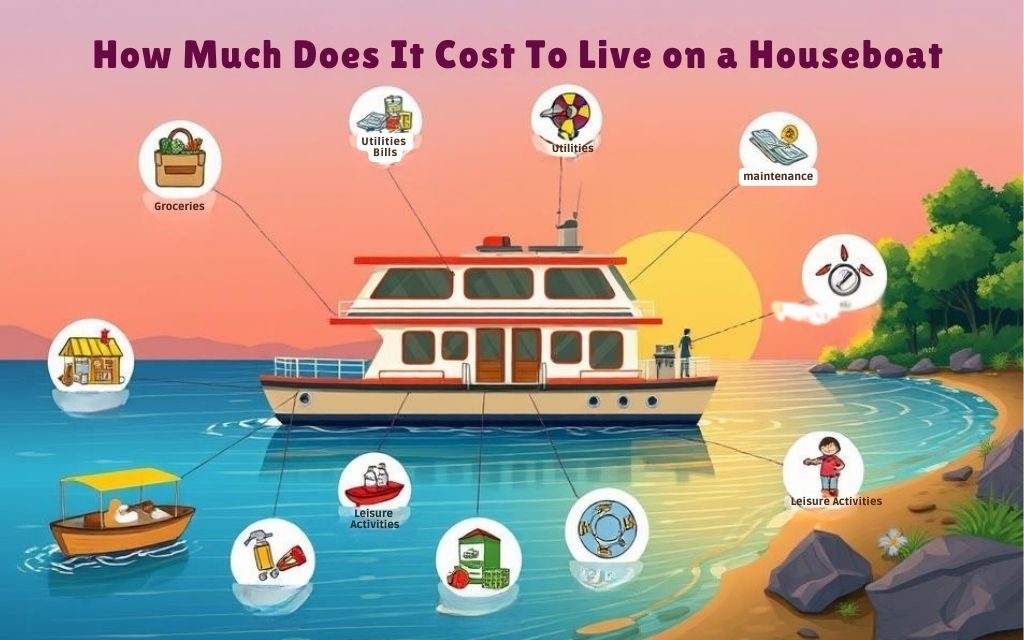Table of Contents
Ever thought about living on a houseboat? It’s a dream of affordable waterfront living for many. But, how much does it really cost, and is it worth it?
Living on a houseboat is a unique choice. It combines the freedom of the water with the comfort of a home. I’ve looked into it, and the costs depend on many things.
Marina fees and maintenance costs are just the start. Houseboat living can be surprisingly cheap for those ready for a new lifestyle. It’s all about understanding the costs.
Key Takeaways
- Houseboat living offers a unique alternative to traditional housing
- Costs can be more affordable than conventional home ownership
- Requires careful financial planning and understanding of ongoing expenses
- Varies significantly based on location and type of houseboat
- Offers possible savings on property taxes and traditional housing costs
Understanding the Basics of Houseboat Living
Exploring floating homes opens up a world of unique living. It’s a mix of adventure and comfort. Those who live in the boating community share its special charm.
Types of Houseboats Available
There are many types of houseboats, each with its own charm:
- Stationary Houseboats: Permanently moored with minimal mobility
- Cruising Houseboats: Fully navigable vessels designed for travel
- Luxury Floating Homes: High-end residences with premium amenities
- Compact Living Boats: Smaller, more affordable options for minimalist living
Key Differences from Traditional Housing
Houseboat living has its own set of rules:
- Limited living space requiring creative storage solutions
- Direct connection with water and natural environment
- Mobility and flexibility of residence location
- Specialized maintenance requirements
“Living on a houseboat isn’t just a housing choice—it’s a complete lifestyle transformation.” – Maritime Living Enthuasiast
Legal Requirements and Regulations
Houseboat living comes with legal hurdles. Local laws cover:
- Marina occupancy permits
- Safety compliance standards
- Environmental protection guidelines
- Registration and documentation
Before diving into houseboat living, research local laws. You’ll need the right permissions for this unique experience.
Initial Purchase Costs and Financing Options
Starting your journey in houseboat ownership means understanding the costs first. Prices vary widely, from around $50,000 for simple models to over $500,000 for the luxury ones.
Looking into houseboat mortgage costs, buyers face a unique financing world. Unlike homes, houseboats don’t fit traditional lending rules. Special marine lenders offer custom plans for these special properties.
“Houseboat budgeting requires careful planning and a complete grasp of both initial and ongoing costs.”
Several factors affect the cost of owning a houseboat:
- Vessel size and type
- Age and condition of the boat
- Construction material
- Included amenities
There are various financing paths for houseboat buyers:
- Marine-specific loans from specialized lenders
- Personal watercraft loans
- Home equity lines of credit
- Manufacturer financing programs
Getting pre-approved and doing your homework is key. Remember to budget for extra costs like surveys, inspections, and possible renovations. Smart financial planning can make your houseboat dream a reality.
How Much Does It Cost to Live on a Houseboat
Houseboat living is a unique way to find affordable housing. It attracts many who love adventure. To understand the costs, we need to look closely at the financial side of this lifestyle.
Monthly Payment Breakdown
Living on a houseboat has several financial aspects to consider. The monthly costs usually include:
- Mortgage or loan payments
- Marina slip fees
- Utility costs
- Insurance premiums
- Maintenance expenses
Seasonal Cost Variations
Houseboat living costs change with the seasons. In winter, you might pay more for heating. Summer might need extra maintenance to fight sun damage and wear.
| Season | Typical Expenses | Estimated Cost Range |
|---|---|---|
| Winter | Heating and Winterization | $300 – $600 |
| Summer | Maintenance and Repairs | $200 – $500 |
| Spring/Fall | General Upkeep | $150 – $400 |
Hidden Expenses to Consider
Before buying a houseboat, think about these unexpected costs:
- Emergency repair funds
- Specialized insurance requirements
- Potential relocation expenses
- Water treatment and sanitation systems
“The true cost of houseboat living goes beyond the monthly payments – it’s an investment in a unique lifestyle,” says marine living expert Sarah Reynolds.
Houseboat living costs can be complex. But with good planning and budgeting, it can be both affordable and exciting.
Marina Fees and Docking Costs Explained
Understanding marina fees and houseboat docking costs is key for boat owners. These costs are important for planning your houseboat life. Marina fees change based on several factors that affect your spending.
The place where you dock your boat matters a lot. Cities by the coast and busy waterfront spots usually cost more. Fees can be as little as $500 or more than $2,000 a month, based on where you are and what’s available.
“Not all marina fees are created equal. Your location and chosen amenities will dramatically impact your monthly expenses.” – Nautical Living Magazine
Several things can change how much you pay for docking your houseboat:
- Where you are
- The marina’s features
- How big and long your boat is
- How long you stay and the season
- Any extra services
It’s smart to look at different places to find the best deal for you. Some marinas give discounts for long stays or certain times of the year. This can help lower your costs.
| Region | Average Monthly Dockage Rates | Typical Amenities |
|---|---|---|
| Pacific Northwest | $800 – $1,500 | Electricity, Water, WiFi |
| Florida Coast | $1,000 – $2,500 | Full-Service Facilities |
| Great Lakes Region | $600 – $1,200 | Basic Utilities |
Looking into mooring buoys or private docks might be cheaper. Always check local rules and compare different marinas to find the best deal for your lifestyle.
Essential Utility Expenses on a Houseboat
Living on a houseboat means you need to plan your utilities carefully. Houseboats face special challenges that can raise your monthly bills. Knowing these costs is key for those thinking about this lifestyle.
Managing houseboat utilities involves several key systems. Here are the main expenses you’ll face:
Water and Electricity Usage
Houseboat utilities often rely on marina services. Most marinas charge for electricity and water, but prices vary a lot.
- Electrical connections cost between $0.10 and $0.25 per kilowatt-hour
- Water fees are about $0.05 to $0.15 per gallon
- Some marinas include these costs in their monthly fees
Heating and Cooling Systems
Keeping your houseboat comfortable needs special gear. Compact marine-grade heating and cooling units are essential but cost more than usual home systems.
| System Type | Average Cost | Energy Efficiency |
|---|---|---|
| Marine Electric Heater | $300 – $800 | Moderate |
| Diesel Cabin Heater | $500 – $1,200 | High |
| Marine Air Conditioner | $1,000 – $2,500 | High |
Internet and Communication Services
Staying connected on a houseboat is tricky. Special mobile hotspots and satellite internet can help.
“Living on a houseboat means getting creative with your communication solutions.” – Marina Living Expert
Understanding these utility costs helps you prepare for houseboat living. It lets you make smart choices about your waterfront lifestyle.
Insurance Requirements and Coverage Costs
Understanding houseboat insurance can be tricky. As a houseboat owner, knowing about insurance is key to protect your home on the water. It also helps manage costs for living on a boat.

Houseboat insurance is different from home or boat insurance. It covers important parts of owning a houseboat:
- Hull insurance protects the boat’s body
- Liability coverage for accidents
- Personal property protection
- Emergency towing and help
Several things affect how much houseboat insurance costs:
- The boat’s age and condition
- Where you sail
- If you live on it full-time or just use it for fun
- Your sailing experience
“Comprehensive coverage is essential for protecting your floating investment,” says marine insurance expert Rachel Thompson.
Houseboat insurance costs usually range from $500 to $2,000 a year. This depends on many factors. Special marine insurers offer the best protection for houseboat owners.
| Coverage Type | Average Annual Cost | Key Protection |
|---|---|---|
| Basic Hull Coverage | $500-$1,000 | Structural damage |
| Comprehensive Protection | $1,000-$2,000 | Full vessel and personal property |
| Liability Coverage | $300-$700 | Third-party incidents |
I suggest talking to an insurance expert who knows about houseboat living. They can find the right coverage for you and your budget.
Maintenance and Repair Expenses
Owning a houseboat comes with unique maintenance challenges. These can significantly impact your budget. Boat maintenance is key to houseboat living, needing careful planning and financial preparation.
Understanding houseboat maintenance costs helps avoid financial surprises. Regular upkeep prevents expensive repairs. It keeps your floating home in top shape.
Regular Maintenance Schedule
A proactive approach to boat maintenance saves money. Here’s a typical maintenance schedule for houseboats:
- Monthly hull inspections
- Quarterly engine checks
- Bi-annual electrical system evaluations
- Annual complete vessel assessment
Emergency Repairs Budget
Unexpected maintenance issues can quickly drain your finances. It’s wise to set aside a dedicated emergency fund for repairs. Budgeting 10-15% of your boat’s value annually is a good strategy.
| Repair Type | Estimated Cost Range | Frequency |
|---|---|---|
| Hull Repairs | $500 – $5,000 | Every 2-5 years |
| Engine Servicing | $300 – $2,000 | Annually |
| Electrical System | $200 – $1,500 | Every 1-3 years |
Professional Service Costs
“An ounce of prevention is worth a pound of cure” – this is true for houseboat maintenance.
Professional services are vital for your houseboat’s upkeep. Typical costs include:
- Marine mechanic inspections
- Hull cleaning and painting
- Electrical and plumbing checks
Regular professional maintenance prevents costly repairs and extends your houseboat’s life.
Fuel and Transportation Considerations
Living on a houseboat comes with its own set of fuel and transportation challenges. The cost of fuel is a big part of your budget for living on the water. The type of houseboat you have affects how much fuel it uses, which changes your living costs.
“Fuel efficiency is key to managing the long-term expenses of houseboat living.” – Maritime Living Expert
Several factors influence fuel costs:
- Propulsion engine type
- Boat size and weight
- How often you move
- Needs for onboard power
Here’s a look at typical fuel use and costs for different houseboats:
| Houseboat Type | Average Fuel Consumption | Monthly Fuel Cost Estimate |
|---|---|---|
| Small Pontoon Houseboat | 2-3 gallons per hour | $150-$250 |
| Mid-Size Cruiser | 5-7 gallons per hour | $350-$500 |
| Large Live-Aboard | 8-10 gallons per hour | $600-$800 |
Transportation is also key. Many owners have a car for trips on land. The place where you dock affects your transportation costs. Some marinas offer shuttles or are close to public transport, which can save money.
To cut down on fuel costs, consider these tips:
- Go for an energy-saving boat design
- Move less often
- Keep your engine in good shape
- Use solar panels for power
Property Taxes and Registration Fees
Understanding houseboat ownership means knowing about property taxes and registration fees. Waterfront homes have special tax rules that might surprise boat owners.
Different states have different rules for houseboat taxes. Some see houseboats as personal property, while others treat them like real estate. This affects how much tax owners pay.
State-Specific Tax Requirements
Taxes on houseboats vary across the U.S. Here are some key points to consider:
- Washington and Oregon often classify houseboats as real property
- Florida typically treats residential boats as personal property
- California has complex tax regulations for waterfront housing
Annual Registration Costs
Every state has its own rules for registering residential boats. The cost depends on the boat’s size and where it’s located.
| State | Annual Registration Fee | Tax Classification |
|---|---|---|
| Washington | $150-$300 | Real Property |
| Florida | $100-$250 | Personal Property |
| California | $200-$400 | Mixed Classification |
“Understanding local houseboat tax regulations is key for planning and avoiding surprises.”
It’s wise to talk to a local tax expert who knows about houseboat taxes. They can give you the latest and most accurate advice for your situation.
Seasonal Preparation and Storage Costs

Managing a houseboat lifestyle budget means planning for the seasons. Houseboating fans know that getting ready for each season is essential. It helps keep their floating home safe all year.
In colder areas, winter is a big deal. To avoid expensive repairs, you need to winterize your boat. The cost depends on your boat’s size and where you live.
- Winterization services: $500 – $2,000
- Protective coverings: $300 – $800
- Antifreeze and specialized treatments: $100 – $300
Choosing where to store your boat is a big decision. It depends on the weather and what you prefer.
| Storage Option | Annual Cost | Protection Level |
|---|---|---|
| Dry Dock Storage | $2,000 – $5,000 | High |
| In-Water Storage | $1,500 – $3,500 | Moderate |
| Covered Slip | $3,000 – $6,000 | Very High |
“Proper seasonal preparation is the secret to maintaining your floating home without breaking the bank.” – Experienced Houseboat Owner
For those in warmer places, other challenges come up. Hurricane preparation is key, with costs for special anchoring, extra insurance, and maybe moving your boat.
Wise houseboat owners set aside 5-10% of their boat’s value each year. This covers seasonal prep and storage. It helps avoid unexpected costs and keeps your boat in good shape.
Tips for Budgeting and Cost Management
Mastering budgeting for houseboat living means planning smart and making wise financial choices. It can be tough, but with the right steps, you can live affordably on a houseboat.
Handling the money side of houseboat living needs careful thought and action. Here are key tips to help you manage costs and stretch your budget.
Money-Saving Strategies for Liveaboards
- Invest in energy-efficient marine appliances
- Learn basic DIY maintenance skills
- Purchase marine supplies during off-season sales
- Negotiate long-term marina slip contracts
- Use solar panels to reduce electricity costs
Financial Planning Tools
Keeping track of your spending is key to a budget-friendly houseboat life. I suggest using apps made for mobile lifestyles to help.
| App Name | Key Features | Cost |
|---|---|---|
| Mint | Budget tracking, expense categorization | Free |
| YNAB | Detailed financial planning, goal setting | $11.99/month |
| PocketGuard | Marina expense tracking, bill monitoring | Free/Pro version |
“Smart budgeting transforms the houseboat lifestyle from a financial challenge to an affordable adventure.”
Successful budgeting for houseboat living is about making a plan that works. It lets you enjoy your unique lifestyle while keeping your finances stable.
Conclusion
Exploring houseboat living has shown me it’s a unique alternative to traditional homes. It’s an affordable way to live on the water, attracting those who love adventure. While it comes with financial challenges, the chance to live by the water is very appealing.
Looking at houseboat vs. traditional housing, we see both ups and downs. The costs are high, but the benefits are worth it for those ready to try something new. It’s clear that understanding the financial side is key.
Success in houseboat living means being well-prepared and having the right mindset. It offers freedom but also requires careful budgeting. Before diving in, it’s important to do your homework and talk to experts.
If you’re interested in houseboat living, see it as a big decision, not just a place to live. It needs dedication, smart money management, and a love for the water. With the right mindset, a houseboat can be more than a home—it’s a life-changing experience.
FAQ
How much does it typically cost to purchase a houseboat?
Houseboat prices vary a lot. You can find a basic used model for $30,000. But, luxury floating homes can cost over $500,000. On average, expect to spend $100,000 to $250,000 for a mid-range houseboat good for full-time living.
What are the monthly living expenses for a houseboat?
Monthly costs range from $1,500 to $4,000. This includes marina fees ($500-$1,500), utilities ($200-$500), insurance ($100-$300), and maintenance ($200-$500). Mortgage payments can also be part of the cost. Prices change based on location, boat size, and marina amenities.
Are marina fees the same everywhere?
No, marina fees vary a lot. In places like California or Florida, you might pay $1,000-$1,500 monthly. But, in less popular areas, fees can be as low as $500. Costs depend on water and electrical hookups, security, and other services.
What additional costs should I budget for when living on a houseboat?
You’ll need to budget for annual maintenance ($1,000-$5,000) and emergency repairs. Don’t forget fuel costs, winterization, insurance, registration fees, and seasonal prep. It’s smart to save an extra 10-20% for unexpected expenses.
Is houseboat living cheaper than traditional housing?
It depends on where you are and your situation. In some places, houseboat living can save 30-50% compared to traditional housing. But, costs vary by region, marina fees, and the houseboat itself. While initial costs might be lower, maintenance and unique expenses can affect savings.
What kind of insurance do I need for a houseboat?
You’ll need marine insurance that covers hull, liability, and personal property. Annual costs range from $300 to $2,000, based on the boat’s value, location, and use. Policies differ from home insurance, so get help from a marine insurance expert.
Are there hidden costs I should be aware of?
Yes. Hidden costs include specialized maintenance, bottom cleaning, annual surveys, winter storage, and transportation. You might also face repairs and relocation costs. These can add thousands to your yearly expenses.
How do utility costs compare to traditional housing?
Utility costs are similar or a bit higher than traditional housing. You’ll pay for electricity, water, waste management, and possibly propane or diesel for heating. Monthly costs range from $200 to $500, depending on your boat’s size and usage.
What are the biggest financial challenges of houseboat living?
Big financial challenges include unpredictable maintenance costs, marina fee increases, and specialized repairs. Weather damages and limited financing options are also concerns. Resale value can be unpredictable, requiring careful financial planning.
Can I live on a houseboat year-round?
Many live on houseboats year-round, but it needs careful planning. You’ll need to winterize in cold climates and possibly move during extreme weather. Make sure your boat is ready for full-time living. Some marinas have rules against year-round living, so check local laws.



